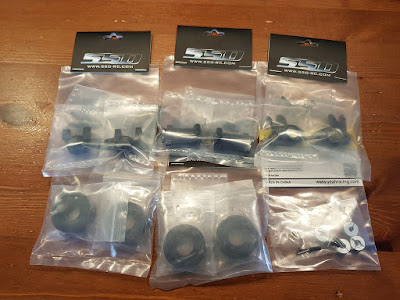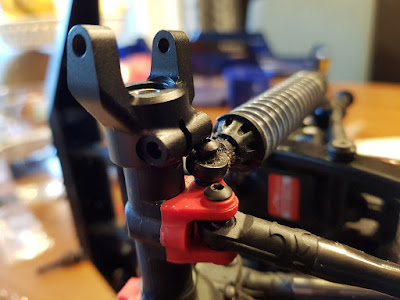Today I visited my first trail event. I've been to other meetings before, but they were either more impromptu crawler sessions or at a track, like the meetings at Speedway Tilburg earlier this year.
It was a 2 day event, but I was only able to visit on Sunday. I asked RC Dork Jr. if he wanted to come along, but he thought that he would need a bit more practice first and decided to stay at home. Looking back, that was a good call, because it probably would have been a bit much for him. Anyway, the weather forecast looked awesome, my batteries were charged and I was looking forward to the event. So with all my gear loaded in the car, I set off on the 45-ish minute drive. There was very little traffic on the road, so I arrived perfectly on time. In the parkinglot I immediately ran into another member of the RC Crawler Scaler Groep. It was good to see a familiar face, so we headed to the assembly point together.
After the usual meeting and greeting and a short explanation about the 2 trails that had been set up for us, we set off for our first trail (a.k.a. Route 2). A short walk along the public road took us from the meeting point to the start of the trail. And right off the bat, the loose sand of the dunes proved to be quite the challenge for some. And once again, the importance of tire choice became obvious. Even though the Axial Ripsaws on my SCX10-II were far from optimal, they held their own on nearly every part of the route(s).
 |
| So... much... sand... |
The routes were clearly marked, but the markers were scale-sized too, so sometimes it was easy to miss one. Also, at some points it was a little confusing. When driving a 1:1, you usually turn when you pass the sign, in this case, you had to turn before the sign. Not a big deal, but it took a little getting used to. The crew had really put an effort into the routes, adding some nice scale details here and there.
 |
| They could have fixed the bridge though... |
There were a few pretty steep climbs and descents in route 2, the loose surfaces didn't really help in remaining in control either. So I did end up flipping my rig a few times. But not quite as often as my buddy Riny, who at some points seemed to spend more time rolling than driving 😁. The added weight down low on my rig seemed to work well, but there's not a lot you can do when the surface under your wheels keeps sliding out from under you. But we made it to the end eventually.
 |
| Made it! |
We arrived back at the meeting point, and while admiring other folks rigs and exchanging tips and tricks we had lunch. The amount of detail on some peoples rigs was downright amazing, and it was good to finally see some of the faces that go with the screen names on the RC Crawler Scaler Groep forum.
I'm pretty sure I could have filled the rest of my day chatting about the hobby, but it was time to set off on the 2nd trail of the day.
Route 1 started off with a few big climbs, and the surface seemed even more loose than on the other trail. A couple of them I was only able to conquer with wheelspeed, there was so little grip. But there was only one climb where I needed to use my 2nd gear.
This trail had a few more man-made elements. A couple of steep climbs up pairs of narrow beams proved too much for the Axial Ripsaws, that were now nicely covered in a thin layer of sand. This was the kind of stuff I tackle in my backyard with ease, but here in the sandy dunes I had to admit defeat.
But then, there it was, the piece de resistance, I had seen a few pics from day 1 pop up on the forum, but in real life, the meters long hanging bridge seemed daunting. The wind had picked up a bit, and people where impatient to try and cross the bridge, so it was not exactly stable, but I got across. It was nerve wrecking, as I stood on the wrong side of the bridge and wouldn't have been able to catch my rig if things went sideways. But I kept my cool and didn't have to watch my rig tumbling down the 25m of sand dune under the bridge.
 |
| Just keep swinging, just keep swinging... |
The next part of the trail was in many aspects quite similar to the other trail, of course, this is to be expected when both trails run through similar terrain. By now, Riny was out of luck, and out of batteries. His back-up pack failed and he only got about 10 minutes of runtime out of it. But he tagged along for the rest of the trail.
After a while, we seemed to have missed a marker, because the trail seemed to end. There was a bench, so we decided to take a break. Not much later, the next group showed up, and we tagged along to get back on the trail. Only a couple of minutes later, we came across a pond, where if you wanted, you could cross by RC ferry. As I still need to give the waterproofing of my rig some attention, I decided not to cross by ferry.
 |
| Cool little markers |
After a short break at the pond, we went on our way again for the last part of the trail. It was nice weather, so a lot of people were spending their day in the dunes. But apparently, some people thought it was funny to (re)move some of the markers, because after a while the markers made no sense. We decided to take a shortcut back to the meeting point.
Not the best shortcut though, because it involved going straight up the highest of the dunes. My knee didn't like that very much as it was pretty close to being overloaded as it was. And (as to be expected) it turned out that for the shortcut, the climbing of the dune wasn't needed at all.
All in all it was a great event. The good folks of RC Junkies & RC Crawler Scaler Groep put a lot of work into setting up the trails and that really showed. Therefore I would like to thank them for their effort.
 |
| See you next time! |







































